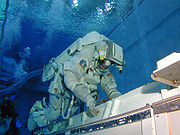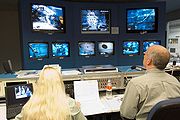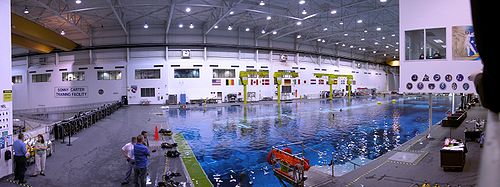
Neutral Buoyancy Laboratory
Encyclopedia



Astronaut
An astronaut or cosmonaut is a person trained by a human spaceflight program to command, pilot, or serve as a crew member of a spacecraft....
training facility maintained by and located at the Sonny Carter
Sonny Carter
Manley Lanier "Sonny" Carter, Jr. was an American physician, professional soccer player, naval officer, and NASA astronaut who flew on STS-33.-Early life:...
Training Facility on NASA
NASA
The National Aeronautics and Space Administration is the agency of the United States government that is responsible for the nation's civilian space program and for aeronautics and aerospace research...
's Johnson Space Center in Houston, Texas
Houston, Texas
Houston is the fourth-largest city in the United States, and the largest city in the state of Texas. According to the 2010 U.S. Census, the city had a population of 2.1 million people within an area of . Houston is the seat of Harris County and the economic center of , which is the ...
. The NBL consists of a large indoor pool of water, the largest in the world, in which astronauts may perform simulated EVA
Extra-vehicular activity
Extra-vehicular activity is work done by an astronaut away from the Earth, and outside of a spacecraft. The term most commonly applies to an EVA made outside a craft orbiting Earth , but also applies to an EVA made on the surface of the Moon...
tasks in preparation for upcoming missions. The NBL contains full-sized mock-ups of the Space Shuttle
Space Shuttle
The Space Shuttle was a manned orbital rocket and spacecraft system operated by NASA on 135 missions from 1981 to 2011. The system combined rocket launch, orbital spacecraft, and re-entry spaceplane with modular add-ons...
cargo bay, flight payloads, and the International Space Station
International Space Station
The International Space Station is a habitable, artificial satellite in low Earth orbit. The ISS follows the Salyut, Almaz, Cosmos, Skylab, and Mir space stations, as the 11th space station launched, not including the Genesis I and II prototypes...
(ISS).
The principle of neutral buoyancy
Neutral buoyancy
Neutral buoyancy is a condition in which a physical body's mass equals the mass it displaces in a surrounding medium. This offsets the force of gravity that would otherwise cause the object to sink...
is used to simulate the weightless environment of space. First the suited astronauts or equipment is lowered into the pool using an overhead crane
Overhead crane
An overhead crane, commonly called a bridge crane, is a type of crane found in industrial environments. An overhead crane consists of parallel runways with a traveling bridge spanning the gap...
. Once this is done the suited astronauts weighted in the water by support divers so that they experience no buoyant
Buoyancy
In physics, buoyancy is a force exerted by a fluid that opposes an object's weight. In a column of fluid, pressure increases with depth as a result of the weight of the overlying fluid. Thus a column of fluid, or an object submerged in the fluid, experiences greater pressure at the bottom of the...
force and no rotational moment
Moment (physics)
In physics, the term moment can refer to many different concepts:*Moment of force is the tendency of a force to twist or rotate an object; see the article torque for details. This is an important, basic concept in engineering and physics. A moment is valued mathematically as the product of the...
about their center of mass
Center of mass
In physics, the center of mass or barycenter of a system is the average location of all of its mass. In the case of a rigid body, the position of the center of mass is fixed in relation to the body...
. The suits worn in the NBL are down-rated from fully flight-rated EMU
Extravehicular Mobility Unit
The Space Shuttle/International Space Station Extravehicular Mobility Unit is an independent anthropomorphic system that provides environmental protection, mobility, life support, and communications for a Space Shuttle or International Space Station crew member to perform extra-vehicular activity...
suits like those in use on the space shuttle and International Space Station.
The NBL tank itself is 202 feet (61.6 m) in length, 102 feet (31.1 m) wide, and 40 in 6 in (12.34 m) deep, and contains 6.2 million gallons (23.5 million litres) of water. Divers breathe nitrox while working in the tank.
One downside of using neutral buoyancy to simulate microgravity is the significant amount of drag
Drag (physics)
In fluid dynamics, drag refers to forces which act on a solid object in the direction of the relative fluid flow velocity...
presented by water. Generally, drag effects are minimized by doing tasks slowly in the water. Another downside of neutral buoyancy simulation is that astronauts are not weightless within their suits, thus, precise suit sizing is critical.
Alternative microgravity simulators
The other primary method used by NASANASA
The National Aeronautics and Space Administration is the agency of the United States government that is responsible for the nation's civilian space program and for aeronautics and aerospace research...
to simulate microgravity is the so-called "Vomit Comet
Vomit Comet
A Reduced Gravity Aircraft is a type of fixed-wing aircraft that briefly provides a nearly weightless environment in which to train astronauts, conduct research and film motion pictures....
", an aircraft which performs a number of parabolic climbs and descents to give its occupants the sensation of zero gravity. The vomit comet reduces the problem of drag in weightless simulation. The main shortcoming of this method is its time limitations - periods of weightlessness are limited to around 25 seconds, interspersed with periods of acceleration of around 2 g
G-force
The g-force associated with an object is its acceleration relative to free-fall. This acceleration experienced by an object is due to the vector sum of non-gravitational forces acting on an object free to move. The accelerations that are not produced by gravity are termed proper accelerations, and...
as the aircraft pulls out of its dive and readies for the next run. This is obviously not suitable for practicing EVAs, which usually last several hours.
Non-NASA, non-US-government neutral buoyancy facilities
The Neutral Buoyancy Research Facility at the University of MarylandUniversity of Maryland, College Park
The University of Maryland, College Park is a top-ranked public research university located in the city of College Park in Prince George's County, Maryland, just outside Washington, D.C...
's Space Systems Laboratory
Space systems laboratory
The Space Systems Laboratory is part of the Aerospace Engineering Department and A. James Clark School of Engineering at the University of Maryland in College Park, Maryland. The Space Systems Laboratory is centered around the Neutral Buoyancy Research Facility, a , water tank that is used to...
performs research into EVA techniques and robotic interaction using neutral buoyancy as a basis for weightless simulation. Equipment is lowered into the pool using an overhead crane
Overhead crane
An overhead crane, commonly called a bridge crane, is a type of crane found in industrial environments. An overhead crane consists of parallel runways with a traveling bridge spanning the gap...
.


